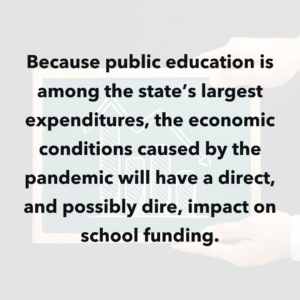 The pandemic is severely impacting government budgets and will have a direct, and possibly dire, impact on public education, the state’s largest expenditure.
The pandemic is severely impacting government budgets and will have a direct, and possibly dire, impact on public education, the state’s largest expenditure.
Public education relies heavily on state funding, much of which comes from sales taxes
§ 45 percent of education funding in Texas comes from state funds, and as property values fall in many areas, that percentage will climb.
§ Sales taxes account for more than 60 percent of all state revenue in Texas.
§ Due to widespread closures and limits put on consumer-oriented businesses, Texas saw the steepest year-over-year decline in sales tax revenue in a decade: a 13.2 percent drop in collections in May 2020. In June 2020, collections were still 6.5 percent below June 2019 collection levels.
§ Rather than the surplus of nearly $3 billion that was once projected for the end of the current biennium, Comptroller Glenn Hegar now
projects a shortfall of $4.6 billion instead.
Oil and gas also have a major effect on the Texas economy
§ Additionally, the price of oil has dropped dramatically. Prices went down from $60 per barrel to less than zero at one point. While the price of oil has recovered to approximately $40 per barrel, that is still much less than the estimated price used to write the current state budget.
§ The Texas economy is closely linked to the natural resources sector, with a direct impact on jobs.
§ As oil prices drop, revenue going into the Economic Stabilization Fund (Rainy Day Fund) slows. Comptroller Hegar projects the Fund will have a balance of $8.8 billion at the end of August 2021 — down from his earlier projection of $9.3 billion.
A downturn will exacerbate questions about the sustainability of school funding
§ In 2019, the Legislature invested $11.6 billion in school finance reform — $6.4 billion in additional funding for public education and $5.2
billion to pay for property-tax relief — but did not create a new revenue source
§ Falling revenues make it difficult to sustain those reforms or fund ongoing property-tax rate compression.
§ The new restrictions on property-tax rates give schools limited room to make up for lost state revenue.
§ The $5.4 billion school funding cuts made in the last major shortfall (2011) reverberated for years.
Much remains unknown about how bleak the budget outlook will be
§ Comptroller Hegar projects a $4.6 billion shortfall for the current biennium and says it’s too soon to know what to expect for 2022-2023.
§ The struggling economy will also likely drive up other state costs, such as health care for low-income Texans.
§ State agencies have been instructed to reduce their budgets by 5 percent in the current biennium.
§ The US Congress provided significant relief to states through the CARES Act, primarily to supplant state funds for schools during the 2019-2020 school year.
§ Unless Congress passes a new aid package for the 2020-2021 school year and/or the economy recovers much more rapidly than expected, funding is uncertain for the upcoming year and beyond.
